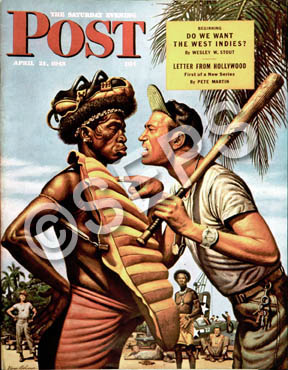Stevan Dohanos (1907-1994)ARTIST GALLERY
"Somewhere between the White Storks of Europe and the American Bald Eagle is the story of my life."

Island Game
4/21/1945
The son of Hungarian immigrants, Stevan Dohanos was born in Lorain, Ohio. Although as a child he would take a stab at copying the many Rockwell pieces he admired, his real interest in art became noticed when he recreated calendar posters for the men at the steel mill where he worked. With coaxing from friends and family, he began to take his talent for art seriously and invested in a two-year home study course. When he had exhausted all of the course work available at this level, he went on the attend Cleveland Art School as a full-time student. Stevan most assuredly personifies a true Horatio Alger success story. A dedicated artist with profound regard for the profession, his works reflect his consuming passion for the simple pleasures life offers at every turn.
After graduation, he worked in Cleveland as a commercial artist. Although he appreciated having a steady job, he longed for artistic freedom in which to express his creative self. In the early 1940's Dohanos settled in the Westport, Connecticut area. He finally worked up the courage to submit several pieces to The Saturday Evening Post, and was awarded his first cover on March 7, 1942, depicting a WWII search light team. Slowly but surely he gained a regular spot in the Posts artistic line up of talented stars. During the next fifteen years, his artwork was highlighted in over one hundred covers. He portrayed the everyday existence of the middle class working man and woman, but his version was exemplified in the scene rather than the individual characters. His view was likened to Edward Hopper in the sense that his perspective was more as the witness rather than the participant. Not interested in bringing the viewer to a conclusion, he simply wanted to document the scene as clearly as he could.
Dohanos had a love and knack for glorifying and committing to canvas each and every American inclination. Dohanos reminisces, "I find myself reconsidering areas and objects that have already found their way into one or more of my paintings. The church, the firehouse, a school, a ball field, all have meaning and visual excitement that varies with the season and the light. "The impressions are eclectic and flow with the movement of an automobile. I gather bits and pieces of story telling material like a busy squirrel and store it in my mental filing system." Texture was an element found in each Dohanos piece. Coming from a working class point of view, the nuance of reminiscence was something that Stevan studied with great intention and expressed masterfully on canvas. He had a gift for capturing the significance of incidentals. He was known for the extensive research he put into each and every piece. He quipped, "I never begin a painting until I have complete and authentic information for a drawing, particularly because I work so realistically and there is no covering up a bit of ignorance with a careless stroke of the brush."
In the story Man Lost, a serial that Dohanos illustrated for The Saturday Evening Post, the only weapon carried by the primitive people in the background was a hulche. Wanting to capture the intricately crafted stick, he traveled to the American Museum of Natural History to sketch a copy of the one he found on display. He then had a replica carved for use by the model in the picture. The painting of this ornate piece carried conviction and authenticity that would reveal itself to anyone clever enough to distinguish this artist's eye for detail. He continued to grace the covers of the Post with one hundred and twenty three covers until the late 1950's when art took a back seat to photographs.
Barely skipping a beat, he sidestepped his talent to a comparable position as the chairman of the National Stamp Advisory Committee. Using his years of collective knowledge as an artist, he was placed in charge of selecting art for postage stamps. "Artists are always interested in seeing their art reproduced", said Stevan Dohanos, a Westport artist and stamp designer. "Imagine seeing your work reproduced four and a half billion times." Mr. Dohanos' worked with stamp art during the administration of seven Presidents of the United States and nine Postmaster Generals. While doing this job he also branched out into paintings of still life using culturally resonant art objects that caught his attention. The artist died at the age of 87 in 1994 leaving behind a body of work that allows his viewer an unglorified yet touching look at some pivotal decades in our nation's history.
